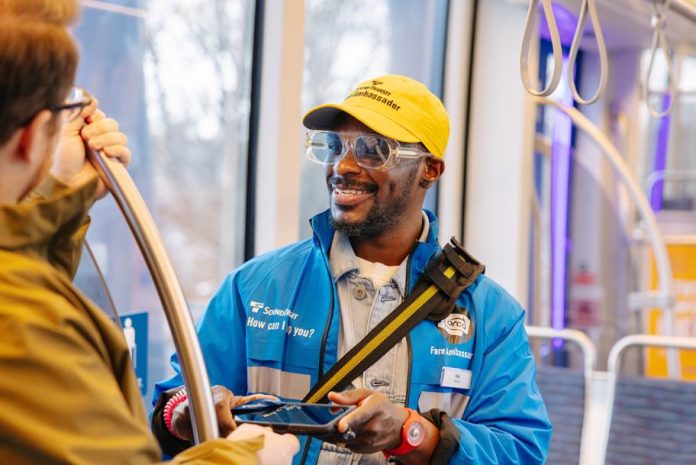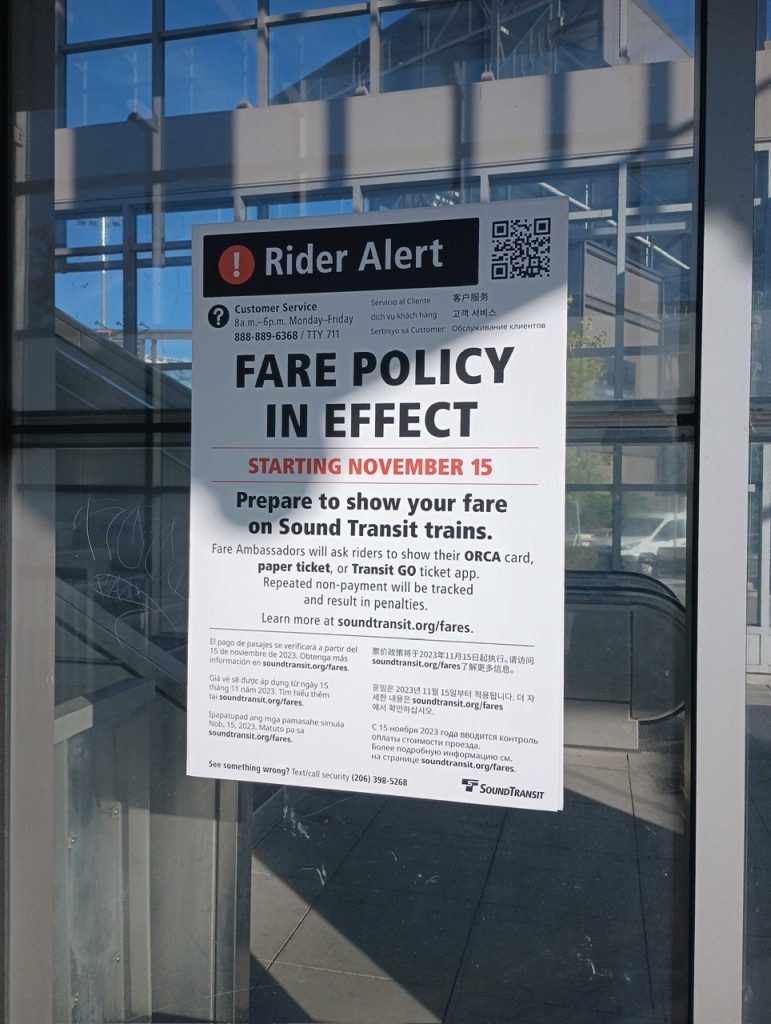
Notices recently started appearing at Link stations to warn riders that more stringent fare enforcement would go into effect later this month. Sound Transit is stepping up penalties for repeat offenses of agency fare policies.
Starting November 15, Sound Transit will begin tracking non-payment offenses that could lead to fines and eventually an infraction referral to district court. The look-back period on offenses is a rolling 12-month window.
Riders that rack up five or more interactions with the agency’s fare ambassadors will face the court referral, which could result in a $124 fine and civil infraction. Any unpaid infraction could eventually lead to a criminal misdemeanor charge. Third and fourth interactions are less severe with violation notices resulting in $50 and $75 fines respectively, though riders could get fines waived by loading their ORCA card with an equal value of the fine, signing a pledge to pay in the future, or participating in an online resolution class or focus group study.
For first and second interactions, fare ambassadors will only provide a warning and educate the rider about the agency’s fare policies and ways to pay, including how to sign up for subsidized fare media options.
Riders found without valid fare payment during a fare check and who fail to then produce some sort of valid identification will be asked to leave the train at the next station. The agency says that refusal to comply with an order to alight from the train will escalate to a security matter. Sound Transit is also in the midst of developing a procedure for photo documentation of riders without valid identification to keep track of their violations, but that won’t be implemented as part of the upcoming changes.

When the new fare enforcement approach is implemented this month, all riders will have their record wiped to zero interactions and new offenses will be tracked, giving riders a clean slate initially. Sound Transit hopes to start increasing the rate of fare checks when the change begins. The agency has a goal of checking 10% of all riders. Staffing retention and hiring, however, has been a challenge for the new fare ambassador program, leading to a fare check rate of only about 1%.
In September, Sound Transit reported that the fare compliance rate on Link was about 87% in the preceding six months. That’s quite a drop from 2018 when the agency reported a fare compliance rate was 97.5%.
This year’s observed compliance rate by fare ambassadors, however, may come with some caveats. Sound Transit’s latest financial plan indicates that the past two years have seen fare media use rates fall to about 55% — well below the 75% target rate that agency hopes to reach by 2029. That could indicate fare checks aren’t capturing the true picture of fare compliance rates right now. New fare check protocols that fare ambassadors use can take a lot longer than the old fare enforcement system, potentially allowing some non-paying riders to slip off at the next station. On the flip side, zero youth fares were introduced last year, which allow youth age 18 and under to ride with or without fare media, so that could explain a sliver of the data.
Earlier this year, the fare ambassador program was running with just 17 members. That meant fare check periods were quite limited. Agency plans call for staffing levels to be around 35 right now and the team is expected to grow to about 75 members by next summer with a goal of 140 members by 2026.
To aid with fare compliance, Sound Transit has been marking “fare paid zones” in downtown tunnel stations, similar to the new Northgate Link Extension stations. This has involved installation of clearer sign and floor markings to delineate areas where riders are supposed to pay to enter. Along with this, ORCA readers have been moved to the zone entrances to consolidate equipment and make it easier for riders to tap on or off for trips, and ticket vending machines have been moved immediately outside the zones for consistency with a signal to pay before entering. More stations outside downtown will get the treatment next year.
Changes to the fare enforcement system were meant to reduce racially disparate impacts and give riders better tools to comply with fare payment policies. That came out of a multi-year process with the pandemic slowing down the pace of change.
Fares make up a fairly small share of Sound Transit’s revenue mix. Just 2% of the proposed 2024 budget is expected to come from fares and the long-term financial plan assumes they will make up nearly 4% of total financing through 2046, with the bulk of fare revenue coming from Link. Systemwide fare collection is less than it was before the pandemic, but it is recovering. The agency says that it collected about $45 million in fares in 2022 and is projecting to take in around $52 million this year and $59 million in 2024. Despite being a small fraction of revenue on a yearly basis, fare revenue is still estimated to fund around $5.5 billion of the long-term finance plan.
In the coming months, the Sound Transit Board of Directors will get to set new farebox recovery targets for agency services as well as a new fare structure for Link.
Policy-wise, Sound Transit’s nascent fare ambassador program has been a source of serious agency board disagreement.
Pierce County Executive Bruce Dammeier and Everett Mayor Cassie Franklin penned a joint op-ed last year decrying fare evasion and using transit for anti-social purposes, and Snohomish County Executive Dave Somers has repeatedly knocked the new fare enforcement system.
“I think it’s going to take more than just some more fare ambassadors and things like that,” Somers said last week. “Our fare retrieval system is almost invisible when you get on the light rail… Going forward in the future, I think this is an area we can substantially improve but it’s going to take some effort, and I think an effort beyond what we’re talking about now.”
King County Councilmember Joe McDermott, long a proponent of a less punitive fare enforcement system, feels differently.
“The board did four years worth of work around fare enforcement, and I would encourage us to make sure we fully implemented the policy we adopted 14 months ago before we chuck it deciding it isn’t working,” McDermott said in response to Somers. “And that does include hiring more fare ambassadors that we have not been able to fully hire, and it does include making sure we’re done marking the ‘pay fare zones’ in all of our light rail stations that we are underway on but not yet completed on.”
Time will tell if staffing up the fare ambassador program is successful and if fare compliance improves, or if the agency board decides to change the fare enforcement system once more. For now, Sound Transit has put out a message to riders to take fare payment seriously or they could face unpleasant consequences.
Stephen is a professional urban planner in Puget Sound with a passion for sustainable, livable, and diverse cities. He is especially interested in how policies, regulations, and programs can promote positive outcomes for communities. With stints in great cities like Bellingham and Cork, Stephen currently lives in Seattle. He primarily covers land use and transportation issues and has been with The Urbanist since 2014.


